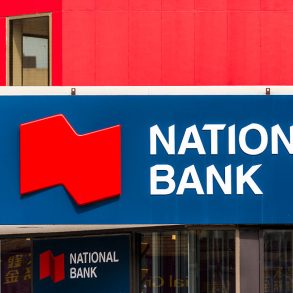Canada’s Big 6 banks wrapped up another earnings season with another $10.69 billion in total net profit.
Earnings were fuelled by strong mortgage growth for at least several banks, notably CIBC, which saw its mortgage volume shoot up 13% from last year, and RBC, with mortgage balances up 6%.
During the shareholder conference calls executives touched on everything from the impact of recent government regulations and forthcoming changes to the B-20 guidelines, to forecasts on further Bank of Canada rate hikes and a potentially softening market in Toronto.
As we do every quarter, we’ve gone through the Big Banks’ quarterly earnings reports, presentations and conference calls, and compiled all the mortgage notables right here. Key tidbits are highlighted in blue.
*********
 Bank of Montreal
Bank of Montreal
Q3 net income: $1.4 billion (+11% Y/Y)
Earnings per share: $2.05
- BMO’s total Canadian residential mortgage portfolio rose to $105.8 billion in Q3, up from $104.1 billion in Q2.
- Mortgage balances were up 4% year-over-year.
- The bank’s mortgage portfolio represents 30% of its total loan book, up from 29% last quarter.
- 52% of BMO’s portfolio is insured, down from 55% in Q2 and down from 57% a year ago.
- The loan-to-value on the uninsured portfolio is 52%, down from 54% last quarter but down from 56% a year ago.
- 69% of the portfolio has an effective remaining amortization of 25 years or less, down from 70% a year ago.
- The condo mortgage portfolio stands at $15.1 billion (up from $14.5 billion in Q3 2016) with 46% insured (down from 50% a year ago).
- Loss rates for the trailing four-quarter period were less than 1 bp and the 90-day delinquency rate was 20 bps, down from 23 bps in Q2 and 22 bps a year ago.
- The bank noted that the Greater Toronto and Greater Vancouver areas “demonstrate better LTV, delinquency rates and bureau scores compared to the national average.”
- BMO’s mortgage portfolio is distributed geographically as follows: 43% in Ontario (down from 44.4% in Q2); 19% in B.C (down from 19.5%); 15% in Alberta (down from 16.1%) and 14% in Quebec (down from 14.9%)
- Net interest margin (NIM) in the quarter was 2.54%, up from 2.49% in Q2 and down from 2.55% in Q3 2016.
Source: BMO Q3 Investor Presentation
Conference Call
- Asked if BMO has made a conscious decision to forego some mortgage growth in the quarter, which is typically a seasonally good quarter for residential mortgages, Cam Folwer, Group Head, Canadian P&C, said the following: “There has been some moderation, so from [an annual percentage increase of] between five and six [per cent] to a number between four and five [per cent]. We’ve been making choices quarter-by-quarter as we move along over the last couple of years…We’re pretty happy where we are right now. …we are undersized nationally, we are undersized in Toronto. So, there are still opportunities for us and we are by no means pulling out of this market.”
- Asked if the bank expects “another leg down” as recent government regulations start to impact the market more, or whether BMO expects to remain in the 4–5% growth range due to it being undersized in the market, Fowler replied: “I think it’s probably a little bit more of the latter. There could be moderation,” he said, noting that the bank is a smaller player in the market. “So, I am not anticipating feeling a meaningful impact on this in 2018. But I think your point about us looking for opportunities elsewhere to balance out in a range that’s similar to where we are now is about the right way to think about it.”
Source: BMO Conference Call
CIBC
Q3 net income: $1.1 billion (-24% Y/Y)
Earnings per share: $2.60
- CIBC’s residential mortgage portfolio rose to $197 billion in Q3, up from $190 billion in Q2 and $175 billion in Q3 2016, or 13% YoY.
- Of the $197-billion mortgage portfolio, $27 billion is from the Greater Vancouver Area (up from $26 billion in Q2), and $60 billion is from the Greater Toronto Area (up from $56 billion in Q2).
- $16 billion of uninsured mortgages were originated in the third quarter, up from $11 billion in Q2. The average LTV of this portfolio was 63% (58% in the GVA and 61% in the GTA). Of that amount, approximately 41% were to clients in the GTA and 14% to clients in the GVA.
- Of the uninsured portfolio, the LTV was 52% (46% in both the GVA and GTA).
- The bank’s HELOC portfolio rose to $21.6 billion in the quarter, up from $20.1 billion a year earlier.
- Net interest margin in Q3 was 237 bps, up 1 bp from Q2 and down from 248 bps in Q3 2016.
- Of the bank’s total mortgage portfolio, 0.23% are in arrears by 90+ days, down from 0.25% in Q2 and 0.26% in Q3 2016.
- For uninsured mortgages, the arrears rate is 0.17%, down from 0.19% in Q2. The arrears rate is 0.07% in the GVA (up from 0.04% a year ago) and 0.06% in the GTA (down from 0.08% a year ago).
- About 6% of the bank’s uninsured portfolio has a Beacon score of 650 or less (down from 8% last quarter). But only 1% of this mortgage portfolio has a Beacon score of 650 or lower and an LTV over 75%.
Source: CIBC Q3 Investor Presentation
Conference Call
- Commenting on the impact of the Bank of Canada’s rate increase, and the bank’s forecast for an additional 25 bps increase before the end of the year and 50 bps in 2018, Victor Dodig said: “The expected impact for CIBC’s Canadian business is a moderation in consumer and mortgage lending activity to reflect the higher interest rate environment and regulatory measures that have been implemented to slow the housing market.”
- “While the HELOC balances grew by 7% over the prior year, the utilization rates have remained relatively constant over the past two years,” said Laura Dottori-Attanasio, Chief Risk Officer.
- Dottori-Attanasio added that the mortgage growth “is mainly attributable to an increase in volume, while we have seen a number of applications decrease marginally over the same period. Our late-stage delinquency rates across all of these portfolios continue to remain low and stable with Vancouver and Toronto performing significantly better than our Canadian average.”
- Asked about the drop in uninsured LTV values from 55% to 52%, Dottori-Attanasio answered: “…as it relates to loan to value, if you will, what we’re seeing in terms of increase is really upon the volume side but as those prices have increased what we’re seeing is that the average size of the mortgage has increased. So that is where that segment of growth is coming from. When you do look at our loan-to-values, I guess what I would say is, we do have adequate buffer to sustain a drop in housing prices.”
- Asked if the slowdown in GTA home sales will translate into a slowdown in the bank’s mortgage portfolio, Christina Kramer, Group Head of Personal & Small Business Banking, replied, “The key driver of our relative growth over the past couple of years has been the steady build-up on the improving productivity of our mobile mortgage advisor team…given that our relative mortgage growth has been largely fuelled by our MA expansion, now that we’re at target state, we expect that the relative mortgage growth rate will begin to converge to industry levels over a few quarters.” Kramer added that given the softening in GTA home sales, “And given the prospect of further regulatory changes, the most notable of which are the amendments [to] the B-20 guidelines, we do anticipate some softening in the market over the upcoming year.”
- Asked for his view on the B-20 guideline changes, CEO Victor Dodig replied: “I think the regulators are going to decide what’s best from a micro prudential perspective for the Canadian economy. Our job, as the leadership team, is to manage within that framework…I think one thing I would say in terms of our overall growth and our consumer franchise, it is growing across the board; we are seeing growth in investment funds; we are seeing growth in deposits. So there’s a high-quality level of growth that we’re seeing, and we’ll continue to endeavour to build those deeper client relationships in our franchise, and that’s the only way for us to deliver value. As regards to regulatory change, I will leave that to our regulators.”
- Asked what percentage of the bank’s residential mortgage portfolio is adjudicated at 200 basis points above the contracted rate, Dottori-Attanasio answered: “The percentage that are currently adjudicated that way would be little over three quarters; but if we were to look at which percentage of our new originations would qualify, that number would actually be in the 90% range…So I am referring to if we were to run our new originations through that rule, how many would qualify.”
Source: CIBC conference call

National Bank of Canada
Q3 net income: $518 million (8.4% Y/Y)
Earnings per share: $1.37 a share
- The bank’s residential mortgage and HELOC portfolio rose to $64.5 billion in Q3, up from $63.5 billion in Q2 and $56.9 billion in Q3 2016.
- Residential mortgage growth was just under 5% year over year.
- The residential mortgage portfolio is 46% insured, down from 47% last quarter, but up from 43% a year ago.
- The average loan-to-value on the HELOC and uninsured mortgage portfolio was 58%, down from 59% in Q2.
- Quebec represented 55% of the mortgage book (unchanged from Q2), while Ontario made up 25% (unchanged) and Alberta 8% (unchanged).
- Net interest margin in Q3 rose to 2.27%, up from 2.24% in Q3 and 2.26% in Q3 2016.
- Uninsured mortgages and HELOCs in the GTA and GTV represented 8% and 2% of the portfolio, respectively, and have an average LTV of 43% and 44%, respectively.
- 27.3% of the bank’s residential mortgage portfolio has a remaining amortization of 25–30 years (down from 28.6% in Q2 and 31.5% a year ago). Another 50.6% has a remaining amortization of 20–25 years (up from 49.4% in Q2 and 45.8% a year ago).
- Gross impaired loans was 34 bps, down from 36 bps last year.
Source: National Bank Q3 Investor Presentation
Conference Call
- “Mortgages continued to drive our revenue growth. In this regard, we are well-positioned being overweight in Quebec,” said CEO Louis Vachon.
- Asked about the bank’s modest residential mortgage growth and its repositioning strategy with Paradigm Quest, Diane Giard, Executive VP, P&C Lending, replied: “We continued to favour a very disciplined approach to our growth by balancing market share gains, margins improvement and also risk management. We also continued to place greater focus on our business development through our own sales force as you know and also in our primary markets. Last quarter as an example, we had 68% of our mortgages that were originated in Quebec compared to 57% in the previous year and also had 78% of our loans originated by our own sales force as opposed to 68% in the previous year. So that’s really what the strategy is going forward. And we expect no major change to our strategy and expect growth to show a slight decrease in momentum to reach nominal GDP in the next year, so it’s somewhat in the area of 4 to 5 per cent.”
Source: National Bank conference call
Royal Bank of Canada
Q3 net income: $2.8 billion (5% Y/Y)
Earnings per share: $1.89
- RBC’s residential mortgage portfolio rose 6% to $251 billion, up from $246 billion in Q2.
- 46% of its mortgages are uninsured, down from 48% in the last quarter.
- The bank noted that while Ontario and B.C. represent 43% and 18%, respectively, of Canadian residential mortgages, both provinces have lower LTV ratios than the Canadian average of 51% (down from 53% in Q2).
- 90+ day delinquencies in the residential mortgage portfolio were 0.20%, down from 0.22% in Q2 and 0.23% a year ago. “Delinquency trends in Alberta remained elevated but were offset by favourable performance in Ontario,” the bank said.
- RBC’s condo exposure is 10% of its mortgage portfolio, up from 9.8% in Q2.
- Average FICO scores of 792 on uninsured mortgages were unchanged from Q2. The bank noted that 47% of uninsured mortgages have a FICO score of 800+, unchanged from Q2.
- 73% of mortgages have a remaining amortization of 25 years or less.
- Net interest margin was 2.61%, down 2 bps from Q3 2016. “We expect some NIM pressure to continue in Q4, but we do expect NIM to stabilize starting in the first quarter,” said CEO David McKay.
Source: RBC Q3 Investor Presentation
Conference Call
- “We continue to prudently grow our mortgage portfolio with strong FICO scores at origination and are seeing low delinquencies,” said CEO David McKay.
- McKay also announce a “significant milestone” for the bank: “Our customers’ mobile sessions surpassed that of online banking. We saw 40% increase in mobile financial transactions over the past year. And to support increasing mobile adoption rates, we released more than 20 new app capabilities to three million-plus mobile customers in the past year,” he said. “RBC clients are now the first in Canada who can ask Siri to pay their bills. We also launched e-Transfer payments within iMessage, giving our clients another innovative payment solution.”
- Regarding the government regulations, Mark Hughes, Chief Risk Officer, said, “…recent policy actions have led to a cooling of the housing market in the GTA over the last few months. Overall, our portfolio remains healthy. Delinquency rates in the GTA remain below average at only 6 basis points.”
- Hughes added: “Year-to-date, the average LTV of new uninsured mortgage originations in the GTA was 65%, with a portfolio LTV of 43%. This provides a solid buffer should Toronto house prices continue to moderate. Given the recent interest rate hike, we continue to monitor the debt serviceability of our clients. We remain comfortable with our portfolio, given a significant proportion of our mortgage originations have been underwritten at the Bank of Canada Qualifying Rate, which is approximately 200 basis points over the contract rate.”
- Regarding runaway housing prices in certain markets, McKay said this: “Certainly, we’ve been calling for a coordinated effort to slow down the growth of house prices in the Canadian markets. We really want to make sure that we have a sustainable Canadian housing market for our economy in particular. And therefore we welcome the changes that have happened so far and the slowing in unit purchase volume and also now you’re starting to see certainly a slowing in small areas [and a] reduction in prices…So we’ll watch the Toronto housing market carefully. Therefore, additional measures may be needed to maintain a healthy balance out there. And we’re encouraged by the existing measures and the effect they’ve had in creating a more sustainable marketplace…So, some of the fine tuning that is coming may be required, given the bounce back we’ve seen in Vancouver and Toronto [but] we’re seeing activity pick up in Montreal and increased activity as some of the investor money shifts there.”
- Additional commentary on the proposed B-20 changes came from Neil McLaughlin, Group Head, Personal & Commercial Banking, who said, “The main point that we think about is the requirement to have a stress test for uninsured mortgages up to 200 basis points over the contract that the client’s paying. The reality is…the vast majority of our applications–upwards of 90%–are already adjudicated at the Bank of Canada posted rate, which is about 200 basis points higher than the client’s contract rate. So we think that’s – that will be quite a modest impact if that’s where we end up. It could – if it gets implemented, it could influence some preferences around term or amortization, but that’s all yet to be determined.”
- Asked about a stabilization of the NIM due to rate hikes, McLaughlin said this: “…we had fixed rate mortgages that we’re booking into the last quarter on quite tight spreads. We increased rates a couple of times, took back about 50 basis points of spread on the mortgage book. As those pull through and fund into Q4, that’ll also give us some stability in NIMs. And also our deposit book–our Canadian consumer deposit book–will start to see an end to quite a successful campaign and that’ll provide some spread back into Q4 and Q1.”
Source: RBC Conference Call
Scotiabank
Q3 net income: $2.1 billion (+7% Y/Y)
Earnings per share: $1.66
- The total portfolio of residential retail mortgages rose to $202 billion in Q3 from $197 billion in Q2, up 6% from $191 billion in Q3 2016.
- The mortgage portfolio was up 5% over the previous year, or 6% excluding the Tangerine mortgage runoff.
- The portfolio comprised $177 billion in freehold properties (up from $173 billion in Q2) and $25 billion in condos (up from $24 billion in Q2).
- 52% of the residential mortgage portfolio was insured in Q3, down from 54% in Q2 and down from 59% in Q3 2016.
- The average LTV of the uninsured portfolio was 50%, down from 51% in Q2.
- Net interest margin rose 3 bps quarter-over-quarter and year-over-year to 2.41%. The bank said this was due to “higher yields in unsecured lending, the impact of the run-off of lower spread Tangerine mortgages, and higher deposit volumes.”
Source: Scotiabank Q3 Investor Presentation
Conference Call
- Asked if the bank expects mortgage growth to pick up, perhaps to 6% levels year-over-year, CEO Brian Porter replied: “I don’t think so. I would expect some moderation in mortgage growth from here. But as we finish 2017 and move into 2018, I’d be thinking about a balance sheet that’s expanding at nominal GDP, maybe plus a bit. So call that broadly 4% to 5%.”
Source: Scotiabank Conference Call
TD Bank
Q3 net income: $2.77 billion (+17% Y/Y)
Earnings per share: $1.51
- TD’s residential mortgage portfolio rose $189.4 billion in Q3, up from $188.1 billion in Q2 and $187.7 billion a year ago.
- The bank’s HELOC portfolio rose to $72.3 billion from $68 billion in Q2.
- 44% of TD’s residential real estate portfolio was insured in Q3, down from 47% in Q2 and 51% in Q3 2016.
- The LTV of TD’s uninsured mortgage portfolio was 58% in Q3, up from 55% in Q2.
- Within the residential mortgage portfolio, gross impaired loans fell to 0.16%, down from 0.19% in Q2.
- Net interest margin in the bank’s retail portfolio rose to 2.81% in Q3, up from 2.78 bps in Q2 and 2.79% a year ago.
Source: TD Bank Q3 Investor Presentation
Conference Call
- Questioned about the bank’s 1% year-over-year mortgage growth and why it’s not pursuing more aggressive growth, Teri Currie, Group Head, Personal Banking, replied: “I think we feel pretty comfortable, and this is in line, if you particularly take out private label purchases with our mid-single-digit growth that we’ve been projecting…we’re under indexed in the highest growth markets of the GVA and GTA, and we’re very comfortable with that. So, I’d say we’re pretty much on track with what we’ve been projecting. We’ll continue to lend prudently and put good risk-adjusted business on our book.”
- Asked about the bank’s purchasing of third-party mortgages, Currie said this: “…the net margins of those purchases hasn’t been as economic over the past period of time. And as such, we’re purchasing when it makes sense. And so, proprietary originations, as I said, just shy of 5%. We will make purchases when the economics are right.”
- Asked about the future pace of growth for HELOCs given the proposed B-20 guideline changes, Currie said he didn’t expect any material impact: “I am not sure that I see a real impact to the product in terms of the loan-to-values for a fixed origination or float origination would be well in line with evolving B20. So, I am pretty comfortable that we should be able to stay on the pace that we’re on.”
Source: TD Conference Call
Note: Transcripts are provided by a third party (Seeking Alpha) and their accuracy cannot be 100% assured.







